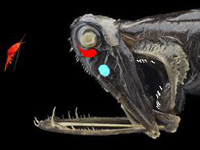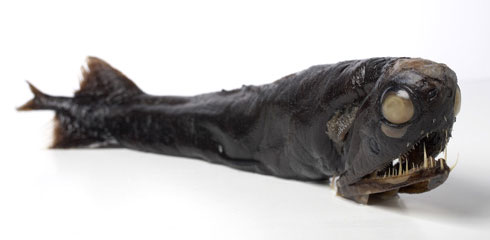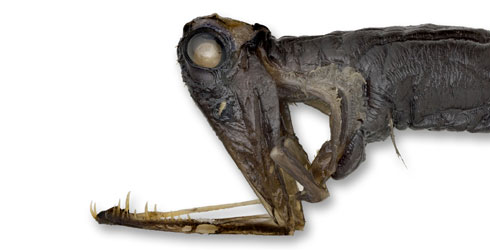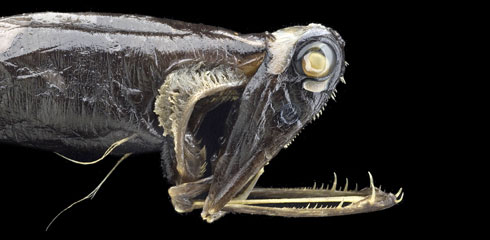Malacosteus niger (stoplight loosejaw)
Watch video footage of the intriguingly named stoplight loosejaw, Malacosteus niger, as its interesting features are discussed by James Maclaine, a fish curator at the Museum.
Malacosteus niger is one of the most bizarre fishes ever discovered. Not only is it capable of producing both red and blue-green light, but it can also dislocate its head in order to lunge out with its lower jaw at prey (much like a dragonfly larva). Hence its common name, the stoplight loosejaw.
It belongs in the family Stomiidae, also known as the dragonfishes.
Unusual abilities

The light organs on this specimen have been coloured in to show the red suborbital photophore (illuminating some prey) and the blue postorbital photophore. The pharyngeal teeth have been highlighted in white.
Malacosteus niger is a relatively small fish with a long body shape and a rounded head. Its huge lower jaw accounts for over 20% of its total length. Both eyes are large and face forward, enabling binocular vision - a rare ability in fishes.
It has 2 large light organs, or photophores, located near each eye. Its ability to produce blue light is shared by many deep-sea fishes but only two other groups of closely related fishes (and a beetle) are known to be able to produce red light.
Since blue light penetrates the dark water of the ocean far more effectively than red, why does M. niger do this? The answer seems to be that very few organisms can see red light, effectively giving the stoplight loosejaw its own private wavelength for communication and hunting.
-

Taxonomy
Learn about the taxonomic studies that have led researchers to believe that Malacosteus niger is one of the most highly specialised fishes within its order, the Stomiiformes.
-

Biology
Discover details about the size and reproduction of this fish, and how it produces light.
-

Diet
Find out how the fish's diet helps it to see red light.
-

Behaviour
Very few specimens of Malacosteus niger have been observed alive in their natural habitat but we are able to deduce something about the fish's behaviour from its appearance and structure. Find out more.
-

Distribution and conservation
Malacosteus niger is found throughout the world's oceans but is more common in the northern hemisphere. It isn't currently endangered. Learn more.
-

References
Some further reading.
Images

The stoplight loosejaw fish, Malacosteus niger

A preserved museum specimen of Malacosteus niger. The red light organ can be seen just below the eye and the postorbital light organ is the small dark patch further down the jaw.

The light organs on this Malacosteus niger specimen have been coloured in to show the red suborbital photophore (illuminating some prey) and the blue postorbital photophore. The pharyngeal teeth have been highlighted in white.

The partial extension of the lower jaw of Malacosteus niger can be seen here. The fish is capable of extending its jaw even further, allowing it to strike out at prey.

It is incredibly difficult to obtain pictures of live Malacosteus, this is a preserved museum specimen.

A Natural History Museum specimen of Malacosteus niger, collected off the Azores from between 800-900m depth.

An old illustration of Malacosteus choristodactylus Vaillant 1888, now considered to be the same species as Malacosteus niger. Taken from Oceanic Ichthyology, Goode & Beane 1896.
